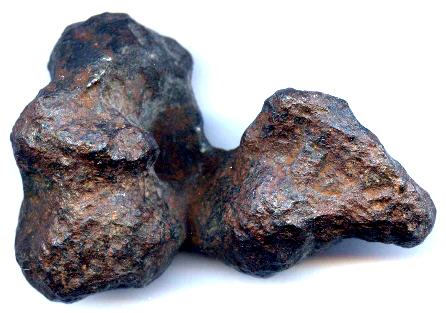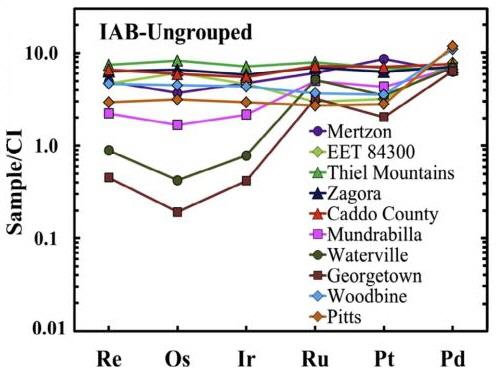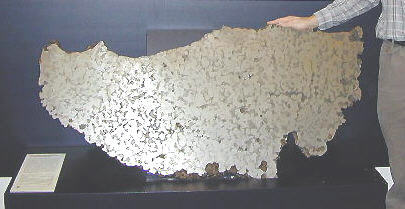Iron, IAB complex, Mundrabilla duo
sLL-an

Found 1911
30° 47′ S., 127° 33′ E. Initially, three small masses known as the Premier Downs masses were found between 1911 and 1918 in Western Australia. Other small specimens were subsequently found and given the names Loongana Station and Loongana Station West. In March of 1966, two larger masses of about 6 and 16 tons were found by geologists R. Wison and A. Cooney and described under the name Mundrabilla. This name was also given to the previously discovered masses without consideration to their former description under the name Premier Downs. The two larger masses, recovered only 180 m apart on the Nullarbor Plain just north of the Transcontinental Railway, can be matched up along similar sharp faces. In 1979, two more large masses weighing approximately one ton each were found by A. Carlisle about 20 km east of the 1966 location. In addition, over 500 small, knuckle-shaped specimens were found distributed along an east–west line of several miles, having a cumulative weight of over 24 tons.
Mundrabilla has a unique granular, polycrystalline structure composed of numerous, randomly oriented, 2–5 cm precursor
taeniteLess common than kamacite, both taenite and kamacite are Ni-Fe alloys found in iron meteorites. Taenite, γ-(Fe,Ni), has 27-65 wt% Ni, and forms small crystals that appear as highly reflecting thin ribbons on the etched surface of a meteorite; the name derives from the Greek word for "ribbon." Click on Term to Read More crystals separated by
schreibersiteNi-Fe phosphide mineral, (Fe,Ni)3P, yellowish in color and predominantly found in iron and stony-iron meteorites. Schreibersite can also be found in a variety of other meteorites including some acapulcoites, aubrites, enstatite chondrites and achondrites, lunars, ureilites, winonaites and a smattering of other meteorite types like CM, CO and CB. Schreibersite Click on Term to Read More,
graphiteOpaque form of carbon (C) found in some iron and ordinary chondrites and in ureilite meteorites. Each C atom is bonded to three others in a plane composed of fused hexagonal rings, just like those in aromatic hydrocarbons. The two known forms of graphite, α (hexagonal) and β (rhombohedral), have Click on Term to Read More, and
troiliteBrass colored non-magnetic mineral of iron sulfide, FeS, found in a variety of meteorites. Click on Term to Read More. The troilite forms veins or lenses several cm long along taenite crystal boundaries, accounting for up to 35 vol% of the
meteoriteWork in progress. A solid natural object reaching a planet’s surface from interplanetary space. Solid portion of a meteoroid that survives its fall to Earth, or some other body. Meteorites are classified as stony meteorites, iron meteorites, and stony-iron meteorites. These groups are further divided according to their mineralogy and Click on Term to Read More. Rare, fine-grained, equigranular silicates similar to
winonaitea partially differentiated asteroid that was disrupted just as it began to form an Fe core and a silicate-rich crust. This disrupting impact mixed silicates into molten Ni-Fe metal forming the silicated IAB irons, and mixed olivine-rich residues of partial melts into unmelted silicates, forming the winonaites. A few winonaites Click on Term to Read More meteorites occur within these sulfide inclusions. Mundrabilla experienced rapid cooling from a melt phase, possibly the result of an impact that caused the disruption and reassembly of the
parent bodyThe body from which a meteorite or meteoroid was derived prior to its ejection. Some parent bodies were destroyed early in the formation of our Solar System, while others like the asteroid 4-Vesta and Mars are still observable today. Click on Term to Read More. Upon etching, an indistinct Thomson (Widmanstätten) structure is visible. Its extended terrestrial age has resulted in the removal of the
fusion crustMelted exterior of a meteorite that forms when it passes through Earth’s atmosphere. Friction with the air will raise a meteorite’s surface temperature upwards of 4800 K (8180 °F) and will melt (ablate) the surface minerals and flow backwards over the surface as shown in the Lafayette meteorite photograph below. Click on Term to Read More along with several mm of the surface, and might be partly responsible for the missing troilite between precursor taenite crystals which gives the large masses their knobby surface appearance.
Under the taxonomic revision of the IAB complex by Wasson and Kallemeyn (2002), both Mundrabilla and Waterville plot near the low-Au, low-Ni subgroup (sLL) with slight deviations. They also share very high (6×) FeS contents, and are therefore considered to be
ungroupedModifying term used to describe meteorites that are mineralogically and/or chemically unique and defy classification into the group or sub-group they most closely resemble. Some examples include Ungrouped Achondrite (achondrite-ung), Ungrouped Chondrite (chondrite-ung), Ungrouped Iron (iron-ung), and Ungrouped Carbonaceous (C-ung). Click on Term to Read More members constituting a duo of the IAB complex; a designation of sLL anomalous is also considered correct. However, further investigation of the IAB complex irons with respect to HSE abundances was conducted by Worsham
et al., 2016). Their data demonstrate that a significant difference exists between the HSE pattern for Mundrabilla and Waterville, with the latter being significantly different from typical IAB irons (see diagram below).

Diagram credit: Worsham
et al.,
GCA, vol. 188, p. 269 (2016)
‘Siderophile elementLiterally, "iron-loving" element that tends to be concentrated in Fe-Ni metal rather than in silicate; these are Fe, Co, Ni, Mo, Re, Au, and PGE. These elements are relatively common in undifferentiated meteorites, and, in differentiated asteroids and planets, are found in the metal-rich cores and, consequently, extremely rare on systematics of IAB complex iron meteorites: New insights into the formation of an enigmatic group’
(https://doi.org/10.1016/j.gca.2016.05.019) In contrast to the time of
metalElement that readily forms cations and has metallic bonds; sometimes said to be similar to a cation in a cloud of electrons. The metals are one of the three groups of elements as distinguished by their ionization and bonding properties, along with the metalloids and nonmetals. A diagonal line drawn Click on Term to Read More segregation and
coreIn the context of planetary formation, the core is the central region of a large differentiated asteroid, planet or moon and made up of denser materials than the surrounding mantle and crust. For example, the cores of the Earth, the terrestrial planets and differentiated asteroids are rich in metallic iron-nickel. Click on Term to Read More formation on the IAB parent body at ~5 m.y. after
Solar SystemThe Sun and set of objects orbiting around it including planets and their moons and rings, asteroids, comets, and meteoroids. formation, the separation of metal in Mundrabilla occurred ~8 m.y. later. At this time radiogenic heating had diminished and only impact-heating could plausibly explain large-scale melting events.
The photo above shows a typical ‘zoomorphic’ individual weighing 150 g consisting of three or four precursor taenite crystals. This mass was shaped by both selective
ablationGradual removal of the successive surface layers of a material through various processes. • The gradual removal and loss of meteoritic material by heating and vaporization as the meteoroid experiences frictional melting during its passage through the atmosphere. The resulting plasma ablates the meteor and, in cases where a meteor Click on Term to Read More of troilite during atmospheric entry and terrestrial weathering processes. The photo below shows the cut surface of a large mass of Mundrabilla.

Photo courtesy of S. Vasiliev

See the ‘Meteorite Men’ episode
Mundrabilla, Australia 21 December 2010, originally broadcast on the Science Channel and now available on
YouTube.










